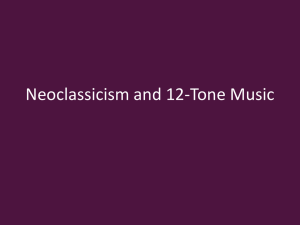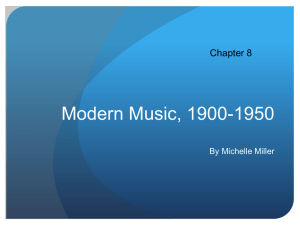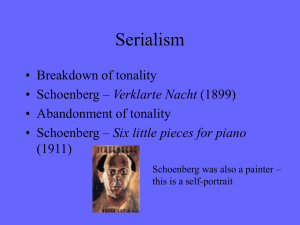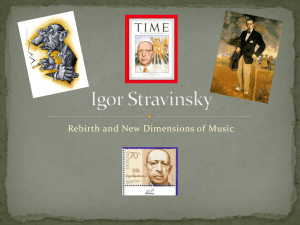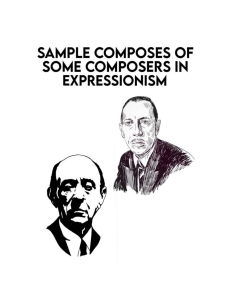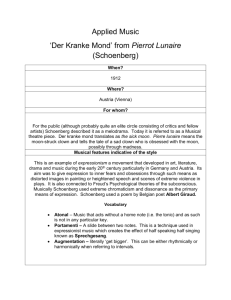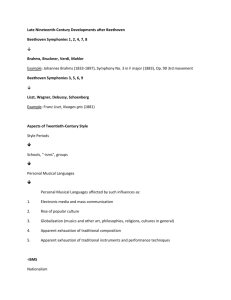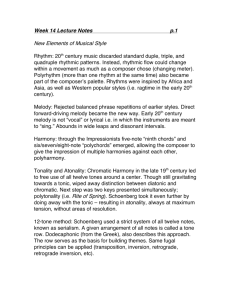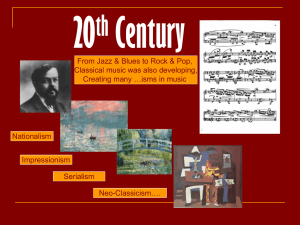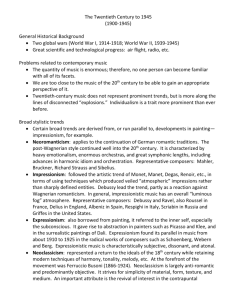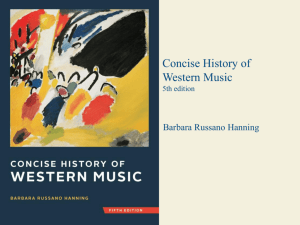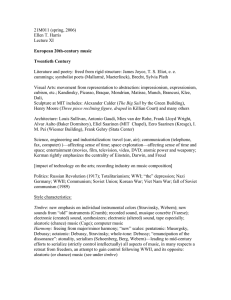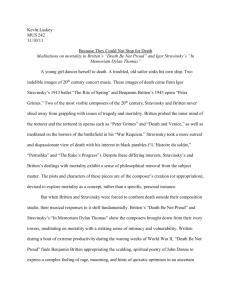Chapter 30
advertisement
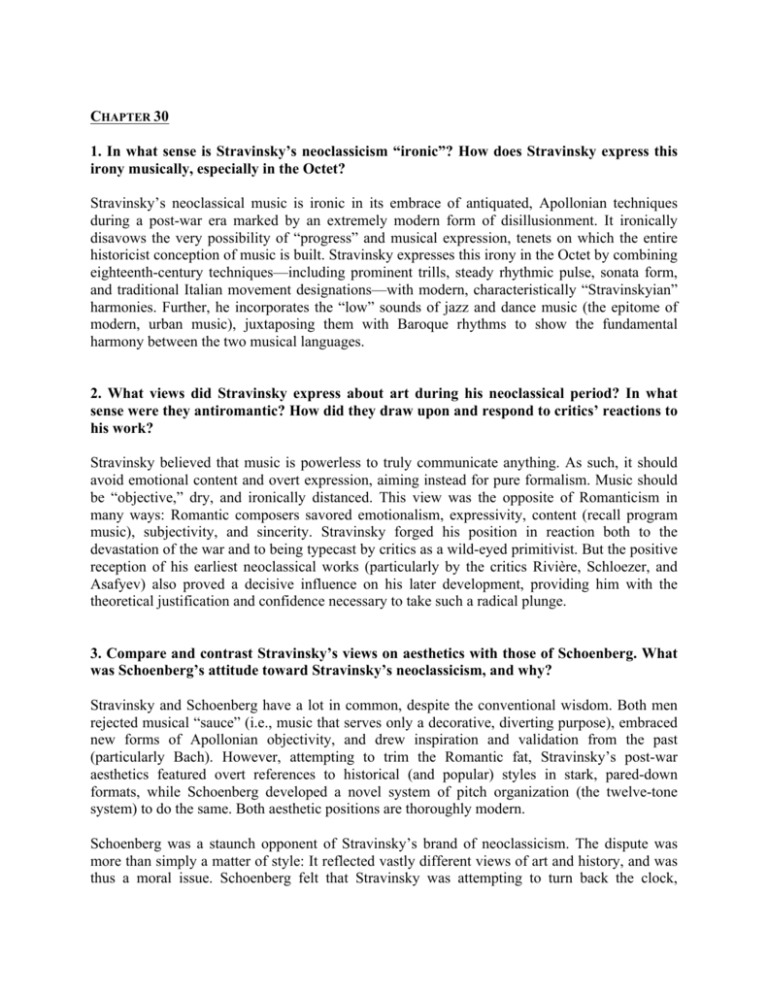
CHAPTER 30 1. In what sense is Stravinsky’s neoclassicism “ironic”? How does Stravinsky express this irony musically, especially in the Octet? Stravinsky’s neoclassical music is ironic in its embrace of antiquated, Apollonian techniques during a post-war era marked by an extremely modern form of disillusionment. It ironically disavows the very possibility of “progress” and musical expression, tenets on which the entire historicist conception of music is built. Stravinsky expresses this irony in the Octet by combining eighteenth-century techniques—including prominent trills, steady rhythmic pulse, sonata form, and traditional Italian movement designations—with modern, characteristically “Stravinskyian” harmonies. Further, he incorporates the “low” sounds of jazz and dance music (the epitome of modern, urban music), juxtaposing them with Baroque rhythms to show the fundamental harmony between the two musical languages. 2. What views did Stravinsky express about art during his neoclassical period? In what sense were they antiromantic? How did they draw upon and respond to critics’ reactions to his work? Stravinsky believed that music is powerless to truly communicate anything. As such, it should avoid emotional content and overt expression, aiming instead for pure formalism. Music should be “objective,” dry, and ironically distanced. This view was the opposite of Romanticism in many ways: Romantic composers savored emotionalism, expressivity, content (recall program music), subjectivity, and sincerity. Stravinsky forged his position in reaction both to the devastation of the war and to being typecast by critics as a wild-eyed primitivist. But the positive reception of his earliest neoclassical works (particularly by the critics Rivière, Schloezer, and Asafyev) also proved a decisive influence on his later development, providing him with the theoretical justification and confidence necessary to take such a radical plunge. 3. Compare and contrast Stravinsky’s views on aesthetics with those of Schoenberg. What was Schoenberg’s attitude toward Stravinsky’s neoclassicism, and why? Stravinsky and Schoenberg have a lot in common, despite the conventional wisdom. Both men rejected musical “sauce” (i.e., music that serves only a decorative, diverting purpose), embraced new forms of Apollonian objectivity, and drew inspiration and validation from the past (particularly Bach). However, attempting to trim the Romantic fat, Stravinsky’s post-war aesthetics featured overt references to historical (and popular) styles in stark, pared-down formats, while Schoenberg developed a novel system of pitch organization (the twelve-tone system) to do the same. Both aesthetic positions are thoroughly modern. Schoenberg was a staunch opponent of Stravinsky’s brand of neoclassicism. The dispute was more than simply a matter of style: It reflected vastly different views of art and history, and was thus a moral issue. Schoenberg felt that Stravinsky was attempting to turn back the clock, restoring and reenacting older musical practices instead of creating new ones. A good historicist, he believed it was the composer’s obligation to advance, and Stravinsky, to him, shirked his responsibilities by regressing. 4. What was the Society for Private Musical Performances? How did it reflect a change in the relationship between the composer and the public? The Society for Private Musical Performances was a concert series created by Schoenberg in post-war Vienna. It was primarily subsidized by subscriptions, and non-members (including music critics) were not allowed to attend. Audiences were small and elite. The society took its cue from the aesthetic attitudes of historicism and the New German School, believing music to be an autonomous art form that must be protected from popular opinion rather than guided by it. The institution thus reflects a new relationship between composers and the public: The artist’s job is to create for the sake of history, not for an audience. Composers should isolate themselves in an “Ivory Tower” with like-minded individuals, for if art has popular appeal, “it is not art.” 5. Describe Schoenberg’s attitude toward the music of the past. Why did he believe he was carrying forward the German musical tradition and assuring Germany’s central position in music history? Schoenberg viewed his twelve-tone technique as a direct descendent of Brahms’s “developing variations” in its motivic density. Rather than a break from the past, twelve-tone music was cast as an inevitable outcome of traditional techniques, a natural evolution toward greater rationality, coherence, and objective transparency. This tie to the (German) past is evident in Schoenberg’s use of archaic forms (e.g., Op. 25, with its minuet, gavotte, and gigue), models closely connected to Bach, the progenitor of German music. By extending the contrapuntal language of Bach, Schoenberg believed he was helping to immortalize the German tradition. 6. Describe how the forty-eight forms of a twelve-tone row are derived in serialism. The basic set of a twelve-tone row is the prime form. The prime can then be transposed (keeping intervallic relationships constant but beginning the row on a different note), inverted (changing the direction of intervallic relationships, e.g., beginning with an ascending fourth instead of descending fourth), and applied in retrograde (backwards). This leads to forty-eight possible varieties of the originating prime row. 7. Compare and contrast the approaches to serialism in the music of Berg and Webern, particularly in Berg’s Lyric Suite and Webern’s Symphony, Op. 21. In what sense is Berg a twelve-tone Romanticist? How do Webern’s works differ from Berg’s? Berg adopted serial techniques to intensify the dramatic force of his music. He was in no way a purist, instead preferring to synthesize twelve-tone writing, free atonality, Romantic gestures, and archaic forms. For example, in his Lyric Suite Berg encodes an autobiographical program into his tone row; the piece’s structural, objective unity and hidden complexity thus work handin-hand with the Romantic values of emotionalism and subjective investment. For this reason, Berg can be considered a twelve-tone Romanticist: He saw serial techniques as a tool for expression, not as a formula with which to transcend expression. In contrast, Webern used serial techniques to achieve an extreme level of compression and control over his musical materials with the goal to create a utopia of unity and objectivity. Unlike Berg, who looked to Romantic models, Webern drew inspiration from the contrapuntal density of Renaissance music. His Symphony, Op. 21 exhibits a characteristic musical economy—the whole pieces lasts just ten minutes—and sparse, pointillistic textures. Its exacting motivic structure and peerless structural unity emphasize intellectual contemplation over emotional ravishment.
